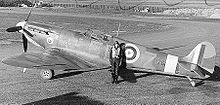Supermarine Aircraft Supermarine Spitfire
 |
|
| Spitfire LF Mk IX, MH434 in 2018 in the markings of its original unit No. 222 Squadron RAF | |
| Role | Fighter / Interceptor aircraft |
|---|---|
| National origin | United Kingdom |
| Manufacturer | Supermarine |
| Designer | R. J. Mitchell |
| First flight | 5 March 1936 |
| Introduction | 4 August 1938 |
| Retired | 1961 (Irish Air Corps) |
| Primary users |
Royal Air Force
|
| Produced | 1938–1948 |
| Number built | 20,351 |
| Variants | Supermarine Seafire |
| Developed into | Supermarine Spiteful |
|
|
|---|
.
History Supermarine Aircraft (Pemberton-Billing)
Supermarine Spitfire
First flight 5 March 1936. Produced 1938–1948

The Supermarine Spitfire is a British single-seat fighter aircraft used by the Royal Air Force and other Allied countries before, during, and after World War II. Many variants of the Spitfire were built, from the Mk 1 to the Rolls-Royce Griffon-engined Mk 24 using several wing configurations and guns. It was the only British fighter produced continuously throughout the war. The Spitfire remains popular among enthusiasts; around 70 remain airworthy, and many more are static exhibits in aviation museums throughout the world.
The Spitfire was designed as a short-range, high-performance interceptor aircraft by R. J. Mitchell, chief designer at Supermarine Aviation Works, which operated as a subsidiary of Vickers-Armstrong from 1928. Mitchell developed the Spitfire's distinctive elliptical wing (designed by Beverley Shenstone) with innovative sunken rivets to have the thinnest possible cross-section, achieving a potential top speed greater than that of several contemporary fighter aircraft, including the Hawker Hurricane. Mitchell continued to refine the design until his death in 1937, whereupon his colleague Joseph Smith took over as chief designer, overseeing the Spitfire's development through many variants...
Development and production
Origins

In 1931, the Air Ministry released specification F7/30, calling for a modern fighter capable of a flying speed of 250 mph (400 km/h). R. J. Mitchell designed the Supermarine Type 224 to fill this role. The 224 was an open-cockpit monoplane with bulky gull wings and a large, fixed, spatted undercarriage powered by the 600-horsepower (450 kW), evaporatively cooled Rolls-Royce Goshawk engine. It made its first flight in February 1934. Of the seven designs tendered to F7/30, the Gloster Gladiator biplane was accepted for service
-
Manufacturing at Castle Bromwich, Birmingham

Spitfire Mk IIA, P7666, EB-Z, Royal Observer Corps, was built at Castle Bromwich, and delivered to 41 Squadron on 23 November 1940. In 1935, the Air Ministry approached Morris Motors Limited to ask how quickly their Cowley plant could be turned to aircraft production. In 1936, this informal request for major manufacturing facilities was replaced by a formal scheme, known as the shadow factory plan, to boost British aircraft production capacity under the leadership of Herbert Austin. He was given the task of building nine new factories, and to supplement the British car-manufacturing industry by either adding to overall capacity or increasing the potential for reorganisation to produce aircraft and their engines.
Photo Gallery
Supermarine Aircraft (Pemberton-Billing)
Supermarine Spitfire
First flight 5 March 1936, Produced 1938–1948


Supermarine Aircraft (Pemberton-Billing)
Supermarine Spitfire
First flight 5 March 1936, Produced 1938–1948
General characteristics
-
-
- Crew: 1
- Length: 29 ft 11 in (9.12 m)
- Wingspan: 36 ft 10 in (11.23 m)
- Height: 11 ft 5 in (3.48 m)
- Wing area: 242.1 sq ft (22.49 m2)
-
Powerplant
-
-
- Empty weight: (2,297 kg)
- Gross weight: (3,004 kg)
- Max takeoff weight: (3,039 kg)
- Powerplant: 1 × Rolls-Royce Merlin 45 V-12 liquid-cooled piston engine, 1,470 hp
-
Performance
- Maximum speed: 370 mph (600 km/h,
- Range: 479 mi (771 km, 416 nmi)
- Combat range: (399 km, 216 nmi)
- Ferry range: 1,100 mi (1,800 km, 960 nmi) with fuel tank
- Service ceiling: 36,500 ft (11,100 m)
Armament
-
-
Guns:
- A wing
- 8 × .303 in Browning Mk II* machine guns (350 rounds per gun)
- B wing
- 2 × 20 mm Hispano Mk II (60 rounds per gun)
- 4 × .303 in Browning Mk II* machine guns (350 rounds per gun)
- A wing
-
Links to Youtube & Others
In 1931, the Air Ministry released specification F7/30, calling for a modern fighter capable of a flying speed of 250 mph (400 km/h). R. J. Mitchell designed the Supermarine Type 224 to fill this role.
Supermarine Aircraft
Supermarine Spitfire
The Supermarine Spitfire is a British single-seat fighter aircraft used by the Royal Air Force and other Allied countries.
Youtube Link
During the Battle of Britain (July–October 1940), the public perceived the Spitfire to be the main RAF fighter; however, the more numerous Hurricane shouldered more of the burden.










.png)


.png)
